Jun Seo
Adaptive Information Routing for Multimodal Time Series Forecasting
Dec 23, 2025Abstract:Time series forecasting is a critical task for artificial intelligence with numerous real-world applications. Traditional approaches primarily rely on historical time series data to predict the future values. However, in practical scenarios, this is often insufficient for accurate predictions due to the limited information available. To address this challenge, multimodal time series forecasting methods which incorporate additional data modalities, mainly text data, alongside time series data have been explored. In this work, we introduce the Adaptive Information Routing (AIR) framework, a novel approach for multimodal time series forecasting. Unlike existing methods that treat text data on par with time series data as interchangeable auxiliary features for forecasting, AIR leverages text information to dynamically guide the time series model by controlling how and to what extent multivariate time series information should be combined. We also present a text-refinement pipeline that employs a large language model to convert raw text data into a form suitable for multimodal forecasting, and we introduce a benchmark that facilitates multimodal forecasting experiments based on this pipeline. Experiment results with the real world market data such as crude oil price and exchange rates demonstrate that AIR effectively modulates the behavior of the time series model using textual inputs, significantly enhancing forecasting accuracy in various time series forecasting tasks.
Task-Adaptive Feature Transformer with Semantic Enrichment for Few-Shot Segmentation
Feb 14, 2022
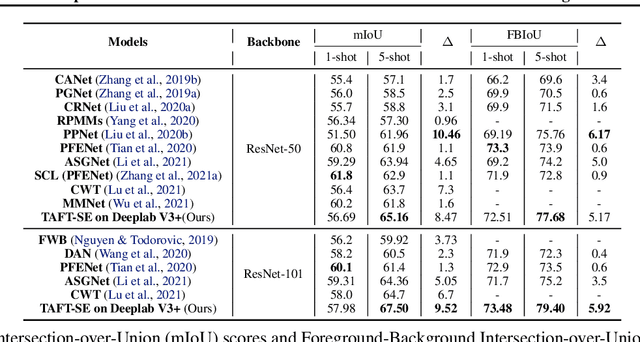

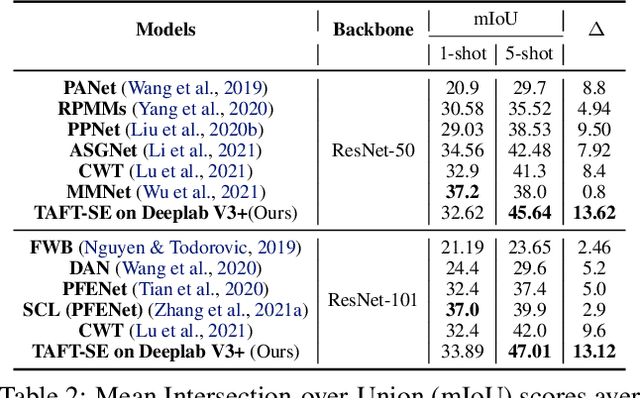
Abstract:Few-shot learning allows machines to classify novel classes using only a few labeled samples. Recently, few-shot segmentation aiming at semantic segmentation on low sample data has also seen great interest. In this paper, we propose a learnable module that can be placed on top of existing segmentation networks for performing few-shot segmentation. This module, called the task-adaptive feature transformer (TAFT), linearly transforms task-specific high-level features to a set of task agnostic features well-suited to conducting few-shot segmentation. The task-conditioned feature transformation allows an effective utilization of the semantic information in novel classes to generate tight segmentation masks. We also propose a semantic enrichment (SE) module that utilizes a pixel-wise attention module for high-level feature and an auxiliary loss from an auxiliary segmentation network conducting the semantic segmentation for all training classes. Experiments on PASCAL-$5^i$ and COCO-$20^i$ datasets confirm that the added modules successfully extend the capability of existing segmentators to yield highly competitive few-shot segmentation performances.
Task-Adaptive Feature Transformer for Few-Shot Segmentation
Oct 22, 2020

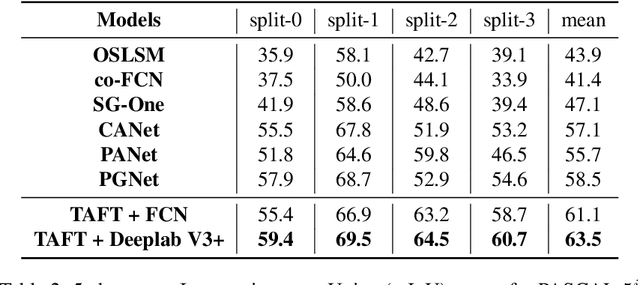
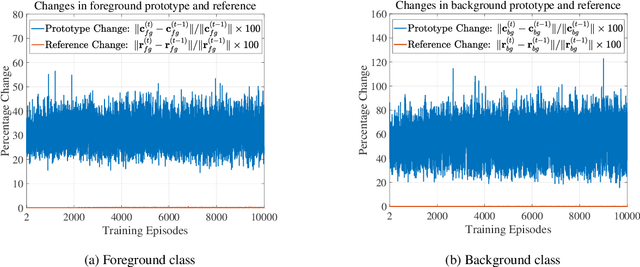
Abstract:Few-shot learning allows machines to classify novel classes using only a few labeled samples. Recently, few-shot segmentation aiming at semantic segmentation on low sample data has also seen great interest. In this paper, we propose a learnable module for few-shot segmentation, the task-adaptive feature transformer (TAFT). TAFT linearly transforms task-specific high-level features to a set of task-agnostic features well-suited to the segmentation job. Using this task-conditioned feature transformation, the model is shown to effectively utilize the semantic information in novel classes to generate tight segmentation masks. The proposed TAFT module can be easily plugged into existing semantic segmentation algorithms to achieve few-shot segmentation capability with only a few added parameters. We combine TAFT with Deeplab V3+, a well-known segmentation architecture; experiments on the PASCAL-$5^i$ dataset confirm that this combination successfully adds few-shot learning capability to the segmentation algorithm, achieving the state-of-the-art few-shot segmentation performance in some key representative cases.
XtarNet: Learning to Extract Task-Adaptive Representation for Incremental Few-Shot Learning
Mar 19, 2020


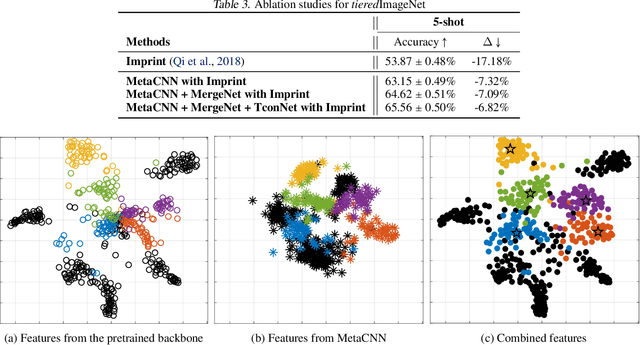
Abstract:Learning novel concepts while preserving prior knowledge is a long-standing challenge in machine learning. The challenge gets greater when a novel task is given with only a few labeled examples, a problem known as incremental few-shot learning. We propose XtarNet, which learns to extract task-adaptive representation (TAR) for facilitating incremental few-shot learning. The method utilizes a backbone network pretrained on a set of base categories while also employing additional modules that are meta-trained across episodes. Given a new task, the novel feature extracted from the meta-trained modules is mixed with the base feature obtained from the pretrained model. The process of combining two different features provides TAR and is also controlled by meta-trained modules. The TAR contains effective information for classifying both novel and base categories. The base and novel classifiers quickly adapt to a given task by utilizing the TAR. Experiments on standard image datasets indicate that XtarNet achieves state-of-the-art incremental few-shot learning performance. The concept of TAR can also be used in conjunction with existing incremental few-shot learning methods; extensive simulation results in fact show that applying TAR enhances the known methods significantly.
CAFENet: Class-Agnostic Few-Shot Edge Detection Network
Mar 18, 2020



Abstract:We tackle a novel few-shot learning challenge, which we call few-shot semantic edge detection, aiming to localize crisp boundaries of novel categories using only a few labeled samples. We also present a Class-Agnostic Few-shot Edge detection Network (CAFENet) based on meta-learning strategy. CAFENet employs a semantic segmentation module in small-scale to compensate for lack of semantic information in edge labels. The predicted segmentation mask is used to generate an attention map to highlight the target object region, and make the decoder module concentrate on that region. We also propose a new regularization method based on multi-split matching. In meta-training, the metric-learning problem with high-dimensional vectors are divided into small subproblems with low-dimensional sub-vectors. Since there is no existing dataset for few-shot semantic edge detection, we construct two new datasets, FSE-1000 and SBD-$5^i$, and evaluate the performance of the proposed CAFENet on them. Extensive simulation results confirm the performance merits of the techniques adopted in CAFENet.
Task-Adaptive Clustering for Semi-Supervised Few-Shot Classification
Mar 18, 2020
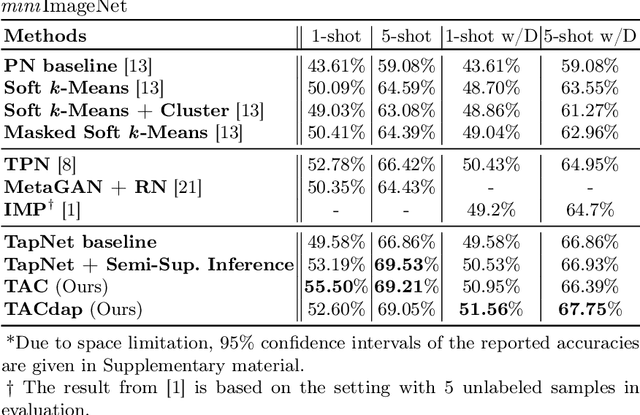

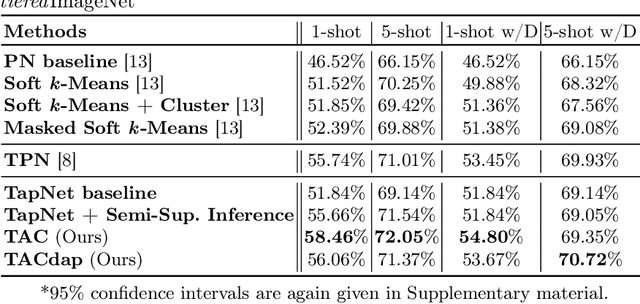
Abstract:Few-shot learning aims to handle previously unseen tasks using only a small amount of new training data. In preparing (or meta-training) a few-shot learner, however, massive labeled data are necessary. In the real world, unfortunately, labeled data are expensive and/or scarce. In this work, we propose a few-shot learner that can work well under the semi-supervised setting where a large portion of training data is unlabeled. Our method employs explicit task-conditioning in which unlabeled sample clustering for the current task takes place in a new projection space different from the embedding feature space. The conditioned clustering space is linearly constructed so as to quickly close the gap between the class centroids for the current task and the independent per-class reference vectors meta-trained across tasks. In a more general setting, our method introduces a concept of controlling the degree of task-conditioning for meta-learning: the amount of task-conditioning varies with the number of repetitive updates for the clustering space. Extensive simulation results based on the miniImageNet and tieredImageNet datasets show state-of-the-art semi-supervised few-shot classification performance of the proposed method. Simulation results also indicate that the proposed task-adaptive clustering shows graceful degradation with a growing number of distractor samples, i.e., unlabeled sample images coming from outside the candidate classes.
TapNet: Neural Network Augmented with Task-Adaptive Projection for Few-Shot Learning
May 16, 2019
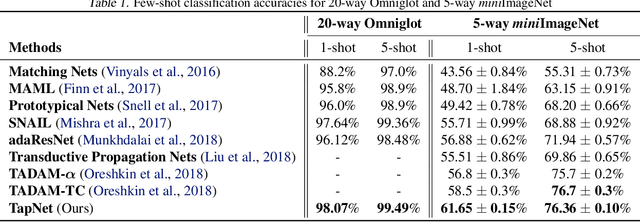

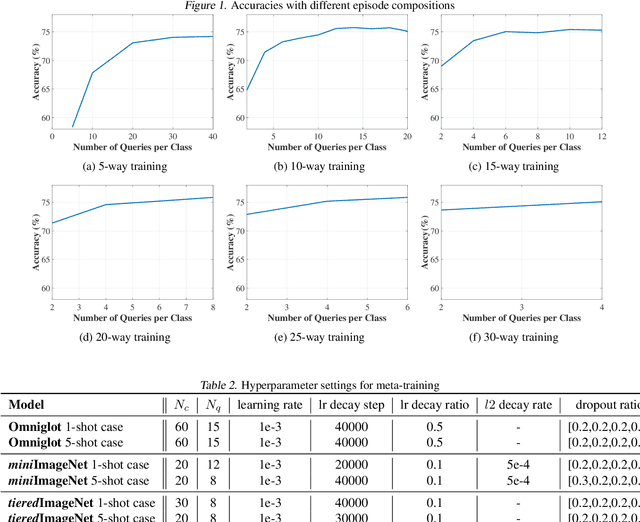
Abstract:Handling previously unseen tasks after given only a few training examples continues to be a tough challenge in machine learning. We propose TapNets, neural networks augmented with task-adaptive projection for improved few-shot learning. Here, employing a meta-learning strategy with episode-based training, a network and a set of per-class reference vectors are learned across widely varying tasks. At the same time, for every episode, features in the embedding space are linearly projected into a new space as a form of quick task-specific conditioning. The training loss is obtained based on a distance metric between the query and the reference vectors in the projection space. Excellent generalization results in this way. When tested on the Omniglot, miniImageNet and tieredImageNet datasets, we obtain state of the art classification accuracies under various few-shot scenarios.
Meta Learner with Linear Nulling
Aug 07, 2018

Abstract:We propose a meta learning algorithm utilizing a linear transformer that carries out null-space projection of neural network outputs. The main idea is to construct a classification space such that the error signals during few-shot training are zero-forced on that space. The final decision on a test sample is obtained utilizing a null-space-projected distance measure between the network output and label-dependent weights that have been trained in the initial meta learning phase. Our meta learner achieves the best or near-best accuracies among known methods in few-shot image classification tasks with Omniglot and miniImageNet. In particular, our method shows stronger relative performance by significant margins as the classification task becomes more complicated.
 Add to Chrome
Add to Chrome Add to Firefox
Add to Firefox Add to Edge
Add to Edge